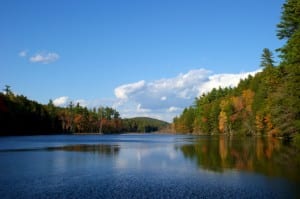
March 2009- By conveying an easement on 450 acres of forestland it owns and manages in Union, CT, Hull Forestlands has helped the Nature Conservancy reach its 50,000 acre mark of protected forests, rivers, and coastline across the state.
The conservation easement, established with the help of a grant from the North American Wetlands Conservation Act (NAWCA), permanently protects Hull Forestlands’ Myers Pond Forest from development and tips the scales for the Nature Conservancy, which has now protected over 50,000 acres of forests, rivers, and coastline in Connecticut.
Located within the Quinebaug Highlands Landscape, an expanse of unbroken forests and sparkling streams in the northeast corner of the state, the Myers Pond Forest has been formally managed for timber production for over 90 years. It is home to wetlands, streams, and forest that are critical wintering and staging areas for migratory waterfowl. As part of the Highlands Landscape, the property also helps sustain the largest drinking water supply watershed in Connecticut, with benefits that trickle down all the way to Long Island Sound.
The Connecticut DEP Natural Diversity Database indicates an observance of Louisiana waterthrush on the Myers Pond property. A variety of habitat types including exceptional sedge/tussock meadow, open water, and riparian and upland habitats are capable of supporting many additional waterfowl and migratory bird species including: black duck, wood duck, hooded merganser, American bittern, sora, American woodcock, marsh wren and Cerulean warbler. Cerulean warbler is considered among the rarest of breeding warblers in Connecticut requiring large blocks of interior forest such as those located on the Myers Pond property. The streams and water bodies of the Myers Pond parcel, including Bigelow Brook, are part of the State of Connecticut DEP designated Natchaug River Greenway.
Hull Forestlands, sister company to Hull Forest Products, the largest hardwood sawmill in the tri-state region, will still own and pay taxes on the property and continue to practice responsible forest management, growing and harvesting timber to meet the needs of society. “We appreciate the opportunity to work with the Nature Conservancy,” says Bill Hull, General Partner of Hull Forestlands. “Unlike some environmental organizations, the Conservancy recognizes that land can be used for multiple purposes—one use is not necessarily exclusive of all others—and they are willing to forge win/win relationships to achieve their goals.”
Hull Forestlands owns several thousand acres of forests in western Massachusetts that have earned certification from the Forest Stewardship Council, and selectively harvested wood from these forests is turned into woody biomass, wood chips, lumber, timbers, and flooring. These private forests also provide public benefits that make them important to the region as a whole, including wildlife habitat, enhanced air and water quality, carbon sequestration, and their contribution the rural character of the New England.







